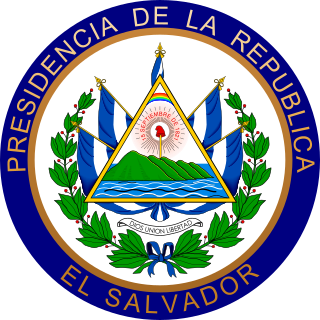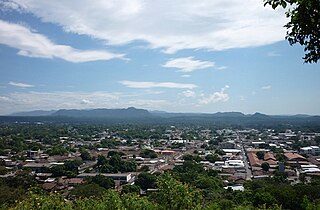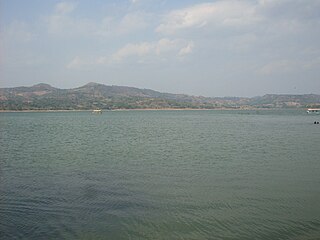
El Salvador, officially the Republic of El Salvador, is a country in Central America. It is bordered on the northeast by Honduras, on the northwest by Guatemala, and on the south by the Pacific Ocean. El Salvador's capital and largest city is San Salvador. As of 2021, the country had a population of approximately 6,825,935.

The economy of El Salvador has experienced relatively low rates of GDP growth relative to other developing countries. Rates have not risen above the low single digits in nearly two decades – part of broader environment of macroeconomic instability which the integration of the US dollar has done little to improve. One problem that the Salvadoran economy faces is the inequality in the distribution of income. In 2011, El Salvador had a Gini Coefficient of .485, which although similar to that of the United States, leaves 37.8% of the population below the poverty line, due to lower aggregate income. The richest 10% of the population receives approximately 15 times the income of the poorest 40%.

The Football War was a brief war fought between El Salvador and Honduras in 1969. Existing tensions between the two countries coincided with rioting during a 1970 FIFA World Cup qualifier. The war began on 14 July 1969, when the Salvadoran military launched an attack against Honduras. The Organization of American States (OAS) negotiated a cease-fire on the night of 18 July, which took full effect on 20 July. Salvadoran troops were withdrawn in early August.

San Salvador is the capital and the most populous city of El Salvador and its eponymous department. It is the country's political, cultural, educational and financial center. The Metropolitan Area of San Salvador, which comprises the capital itself and 13 of its municipalities, has a population of 2,404,097.

Santa Ana is the second largest city in El Salvador, after the capital of San Salvador. It is located 64 kilometers northwest of San Salvador, the capital city. Santa Ana has approximately 374,830 (2017)) inhabitants and serves both as the capital of the department of Santa Ana and as the municipal seat for the surrounding municipality of the same name. For its administration the municipality is divided into 35 colonias (neighborhoods) and 318 small villages.

The president of El Salvador, officially known as the president of the Republic of El Salvador, is the head of state and head of government of El Salvador. He is also, by Constitutional Law, the commander-in-chief of the Armed Forces of El Salvador. The office was created in the Constitution of 1841. From 1821 until 1841, the head of state of El Salvador was styled simply as Head of State.

Cabañas is a department of El Salvador in the north central part of the country. Its capital is Sensuntepeque and it is one of coolest parts of El Salvador. Classified as a department in February 1873, it covers an area of 1,103.5 km2 (426.1 sq mi) and has over 164,900 inhabitants. The other major city of the department is Ilobasco. Agricultural produce includes coffee, sugar cane and sesame seeds, as well as dairy products. Gold, silver and copper are the principal minerals mined in the department. Its main industrial activity is oriented to manufacture of potteries, cheese, lime and also distilleries.

The El Salvador national football team represents El Salvador in international football, and is governed by the Salvadoran Football Federation (FESFUT).

Ahuachapán is a city, and municipality, and the capital of the Ahuachapán Department in western El Salvador. The municipality, including the city, covers an area of 244.84 km² and as of 2007 has a population of 110,511 people. Situated near the Guatemalan border, it is the westernmost city in the country and is the center of an agricultural region producing primarily coffee.

Sonsonate is a city and municipality of El Salvador. It is the capital of the department of Sonsonate; on the Sensunapan River and the Pan-American Highway from San Salvador to the Pacific port of Acajutla, 21 km (13 mi) south. Pop. (2007), about 71,541.

The Salvadoran Civil War was a civil war in El Salvador which was fought between the military-led junta government of El Salvador and the Farabundo Martí National Liberation Front (FMLN) from 15 October 1979 to 16 January 1992. A coup on October 15, 1979, was followed by killings of anti-coup protesters by the government and of anti-disorder protesters by the guerrillas, and is widely seen as the start of civil war.
Salvadorans, also known as Salvadorians, Salvi or Salvadoreans, are citizens of El Salvador, a country in Central America. Most Salvadorans live in El Salvador, although there is also a significant Salvadoran diaspora, particularly in the United States, with smaller communities in other countries around the world.

Andrés Alexander Flores Mejía is a Salvadoran professional footballer.

The Lempa River is a 422-kilometre (262 mi) long river in Central America.
Water resources management in El Salvador is characterized by difficulties in addressing severe water pollution throughout much of the country's surface waters due to untreated discharges of agricultural, domestic and industrial run off. The river that drains the capital city of San Salvador is considered to be polluted beyond the capability of most treatment procedures.

Afro Salvadorans are the descendants of the Sub-Saharan Africans brought to El Salvador via the Trans-atlantic slave trade during the colonial Spanish era.

Nayib Armando Bukele Ortez is a Salvadoran politician and businessman who is the 43rd and current President of El Salvador. He has served since 1 June 2019 after winning the 2019 election. He ran as the candidate of the center-right Grand Alliance for National Unity (GANA) party and became the first president since José Napoleón Duarte (1984–1989) not to have been elected as the candidate of one of the country's two major political parties: the Farabundo Martí National Liberation Front (FMLN) and the Nationalist Republican Alliance (ARENA). He is also the founder of the political party Nuevas Ideas (NI).

The Cerrón Grande Reservoir, also known locally as Lake Suchitlán, is a reservoir in northern El Salvador and the largest body of fresh water in the country. The reservoir was filled between 1973 and 1976, subsequent to the construction of the Cerrón Grande Hydroelectric Dam. The Cerrón Grande Reservoir is among the most polluted bodies of fresh water in Central America.
















